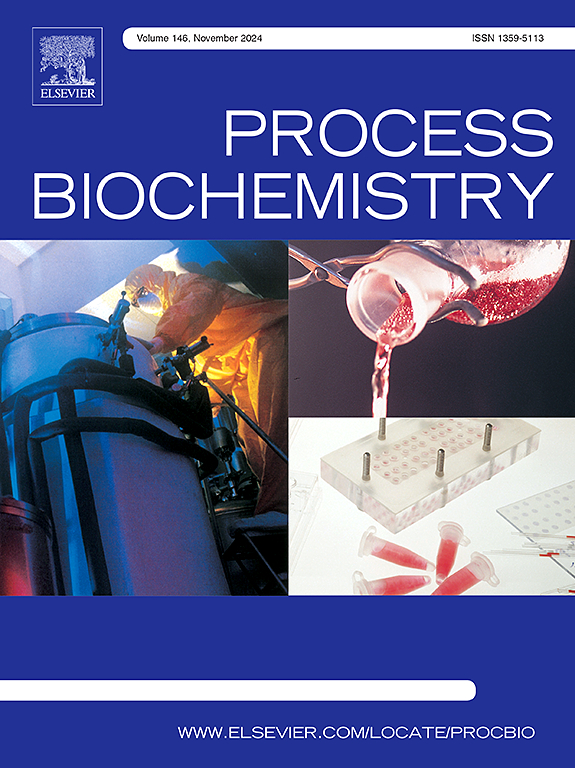Production of single cell protein from sugarcane molasses for feed protein and techno-economic analysis
IF 4
3区 生物学
Q2 BIOCHEMISTRY & MOLECULAR BIOLOGY
引用次数: 0
Abstract
The livestock industry has undergone rapid expansion in recent years, resulting in an increased demand for feed protein. The production of plant and animal proteins cannot sustainably meet the expanding demand for protein, and the development of single cell protein (SCP) as a feed protein is a promising avenue. Molasses is a cheap and nutritious by-product of sugar production from sugarbeet and sugarcane, and is one of the common substrates available to microorganisms. In this study, R. glutinis As 2.703 was used to produce SCP by fermentation with inexpensive carbon source molasses and nitrogen source corn steep liquor instead of glucose and yeast extract, respectively. The results revealed that when the concentration of molasses in the substrate was 61 g/L, the biomass concentration reached 21.0 g/L, and the protein, lipid, carotenoid contents in dry cell were 30.4 %, 7.8 %, and 31.7 μg/g, respectively. SuperPro Designer was used to simulate the process and carry out the economic analysis for producing SCP from 100,000 tons of molasses annually. A plant of this size could produce 32,908 tons/year of SCP at cost of 988.2 USD/ton with payback period of 6.3 years. Sensitivity analysis showed that the selling price of SCP has the greatest impact on the economics of industrial production of SCP, and that by increasing its protein and carotenoid content, its value can be increased, and further increasing its selling price is the key to achieving industrialisation. This study provides new ideas to cope with the future protein feed crisis.
用甘蔗糖蜜生产饲料蛋白用单细胞蛋白及其技术经济分析
近年来,畜牧业迅速发展,导致对饲料蛋白质的需求增加。植物蛋白和动物蛋白的生产无法持续满足日益增长的蛋白质需求,开发单细胞蛋白(SCP)作为饲料蛋白是一条很有前途的途径。糖蜜是甜菜和甘蔗制糖的一种廉价且营养丰富的副产品,是微生物可利用的常见底物之一。本研究以R. glutinis As 2.703为原料,分别用廉价的碳源糖蜜和氮源玉米浸泡液代替葡萄糖和酵母浸膏发酵生产SCP。结果表明,当底物中糖蜜浓度为61 g/L时,生物量浓度达到21.0 g/L,干细胞中蛋白质、脂肪和类胡萝卜素含量分别为30.4 %、7.8 %和31.7 μg/g。利用SuperPro Designer对年产10万吨糖蜜生产SCP的工艺过程进行了模拟,并进行了经济分析。该规模装置可生产SCP 32908吨/年,成本为988.2美元/吨,投资回收期为6.3年。敏感性分析表明,SCP的销售价格对SCP工业化生产的经济性影响最大,通过提高其蛋白质和类胡萝卜素含量,可以提高其价值,进一步提高其销售价格是实现工业化的关键。本研究为今后应对蛋白质饲料危机提供了新的思路。
本文章由计算机程序翻译,如有差异,请以英文原文为准。
求助全文
约1分钟内获得全文
求助全文
来源期刊

Process Biochemistry
生物-工程:化工
CiteScore
8.30
自引率
4.50%
发文量
374
审稿时长
53 days
期刊介绍:
Process Biochemistry is an application-orientated research journal devoted to reporting advances with originality and novelty, in the science and technology of the processes involving bioactive molecules and living organisms. These processes concern the production of useful metabolites or materials, or the removal of toxic compounds using tools and methods of current biology and engineering. Its main areas of interest include novel bioprocesses and enabling technologies (such as nanobiotechnology, tissue engineering, directed evolution, metabolic engineering, systems biology, and synthetic biology) applicable in food (nutraceutical), healthcare (medical, pharmaceutical, cosmetic), energy (biofuels), environmental, and biorefinery industries and their underlying biological and engineering principles.
 求助内容:
求助内容: 应助结果提醒方式:
应助结果提醒方式:


